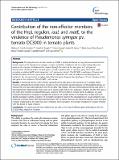Por favor, use este identificador para citar o enlazar a este item:
http://hdl.handle.net/10261/160759COMPARTIR / EXPORTAR:
 SHARE SHARE
 CORE
BASE CORE
BASE
|
|
| Visualizar otros formatos: MARC | Dublin Core | RDF | ORE | MODS | METS | DIDL | DATACITE | |

| Título: | Contribution of the non-effector members of the HrpL regulon, iaaL and matE, to the virulence of Pseudomonas syringae pv. tomato DC3000 in tomato plants |
Autor: | Castillo-Lizardo, Melissa Gissel; Aragón, Isabel M. CSIC; Carvajal Rodríguez, Lida Vivian CSIC; Matas, Isabel M. CSIC; Pérez-Bueno, María Luisa CSIC ORCID; Gallegos, María Trinidad CSIC ORCID ; Barón Ayala, Matilde CSIC ORCID; Ramos, Cayo CSIC ORCID | Palabras clave: | Pseudomonas syringae pv Tomato DC3000 |
Fecha de publicación: | 19-ago-2015 | Editor: | BioMed Central | Citación: | BMC Microbiology 15: 165 (2015) | Resumen: | © 2015 Castillo-Lizardo et al. Background: The phytohormone indole-3-acetic acid (IAA) is widely distributed among plant-associated bacteria. Certain strains of the Pseudomonas syringae complex can further metabolize IAA into a less biologically active amino acid conjugate, 3-indole-acetyl-ε-L-lysine, through the action of the iaaL gene. In P. syringae and Pseudomonas savastanoi strains, the iaaL gene is found in synteny with an upstream gene, here called matE, encoding a putative MATE family transporter. In P. syringae pv. tomato (Pto) DC3000, a pathogen of tomato and Arabidopsis plants, the HrpL sigma factor controls the expression of a suite of virulence-associated genes via binding to hrp box promoters, including that of the iaaL gene. However, the significance of HrpL activation of the iaaL gene in the virulence of Pto DC3000 is still unclear. Results: A conserved hrp box motif is found upstream of the iaaL gene in the genomes of P. syringae strains. However, although the promoter region of matE is only conserved in genomospecies 3 of this bacterial group, we showed that this gene also belongs to the Pto DC3000 HrpL regulon. We also demonstrated that the iaaL gene is transcribed both independently and as part of an operon with matE in this pathogen. Deletion of either the iaaL or the matE gene resulted in reduced fitness and virulence of Pto DC3000 in tomato plants. In addition, we used multicolor fluorescence imaging to visualize the responses of tomato plants to wild-type Pto DC3000 and to its ΔmatE and ΔiaaL mutants. Activation of secondary metabolism prior to the development of visual symptoms was observed in tomato leaves after bacterial challenges with all strains. However, the observed changes were strongest in plants challenged by the wild-type strain, indicating lower activation of secondary metabolism in plants infected with the ΔmatE or ΔiaaL mutants. Conclusions: Our results provide new evidence for the roles of non-type III effector genes belonging to the Pto DC3000 HrpL regulon in virulence. | Versión del editor: | http://doi.org/10.1186/s12866-015-0503-8 | URI: | http://hdl.handle.net/10261/160759 | DOI: | 10.1186/s12866-015-0503-8 | Identificadores: | doi: 10.1186/s12866-015-0503-8 issn: 1471-2180 |
| Aparece en las colecciones: | (EEZ) Artículos |
Ficheros en este ítem:
| Fichero | Descripción | Tamaño | Formato | |
|---|---|---|---|---|
| ContributionBMC2015.pdf | 3,43 MB | Adobe PDF |  Visualizar/Abrir |
CORE Recommender
PubMed Central
Citations
10
checked on 10-abr-2024
SCOPUSTM
Citations
20
checked on 15-abr-2024
WEB OF SCIENCETM
Citations
19
checked on 29-feb-2024
Page view(s)
299
checked on 18-abr-2024
Download(s)
240
checked on 18-abr-2024
Google ScholarTM
Check
Altmetric
Altmetric
Artículos relacionados:
NOTA: Los ítems de Digital.CSIC están protegidos por copyright, con todos los derechos reservados, a menos que se indique lo contrario.
